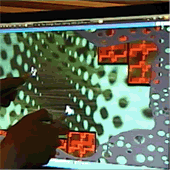
Introduction
It is a very exciting time to be alive. Technology is soaring and expanding exponentially as Moore’s law predicts. Production that previously took teams of people can now be accomplished on a home computer. Everything is becoming smart, and life convenience has gone up immensely. I’ve mailed maybe two letters in my life, thanks to the Internet I can bank and pay bills on line. But what does this have to do with art? Every aspect of life has been modernized, and surely Art is no exception.
“New Media Artists” have emerged and are delivering ground breaking concepts everyday, around the world. Jennifer Stienkamp has made some amazing pieces with professional computer software and lcd projectors. I highly recommend visiting her site and watching her demo reels. But the area that I see missing is novel interaction on installation pieces. For this project I made a proof of concept for future digital art.
The Concept
Imagine a giant installation piece that is a multitouch surface. If you aren’t familiar with multitouch, check here as well as on youtube for many amazing videos about the near future. The surface would be an intelligent piece. Instead of the artist making a looping animation, or static image, the artist would create a piece that is fully modifiable. Not just by one user, but by as many who wish to play with it at a time. The artists would create objects and rules for the piece to work by. The viewers would be allowed complete freedom to approach the wall, touch it, move things, rotate things, size things. The user would be limited to the rules the artist set. Because the piece is modifiable by unlimited users and has sufficient freedom (no preprogrammed scenarios, but rather a world of possibilities) the piece would evolve over time. At any given moment the current state of the piece is the sum total of all previous interactions to that point. Lets imagine a piece with lots of interesting blocks. One person enters the gallery and moves them all to a pile on the left hand side. The next person to enter the room sees this pile, but they take the pile and adjust it to look like a house on the left had side. The third person see’s the house and borrows some blocks to make a tree. The four person see’s the sum total of the previous three people’s actions. Then someone comes in and knocks everything down. There would have been nothing to knock if nothing was built. It continues to evolve. Of course the idea of a block system is one of many possibilities. Fluids could be programmed, or puppets, or abstract objects that interact with each other by novel rules. The possibilities are limitless and the component is that anyone can come up to change it, further they are encouraged to do so. Another interesting application would be to record all the users inputs / modifications from the beginning of the installation. Then play back a video and watch it transform (perhaps in high speed) as the days go by and people play with it.
The Project
I had recently found a video on the Internet that teaches you how to use a Nintendo wiimote to make a multitouch surface. It’s limited to only four inputs, and you have to have light pens but it’s neat and get’s the job done. Check out Johnny Lee’s Wiimote hacking page, he is the original guy to figure this technology out. I used C# to program a general abstract piece that has multi touch capabilities. If you noticed, the paint always drips downward no matter how you rotate it. This would be an example of a rule. The artist states that paint will always drip down, but allows the viewer the freedom to arrange the paint shape however they like. Another rule in my project is the background in the red tiles. Even though the tiles can be moved, the computer makes sure that the pattern is always continuous between tiles. Again freedom to change the environment, but not break the rules. There are a few more in the video see if you can find them.
November 22, 2012 at 1:33 am | Art, Video